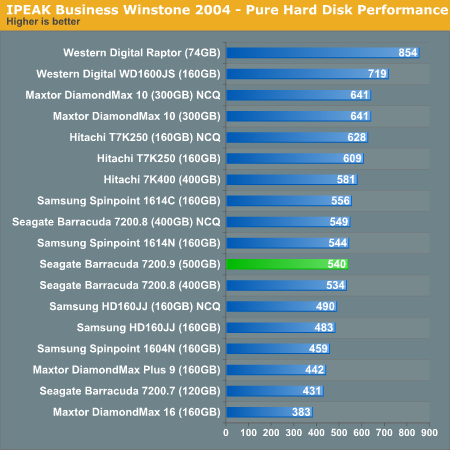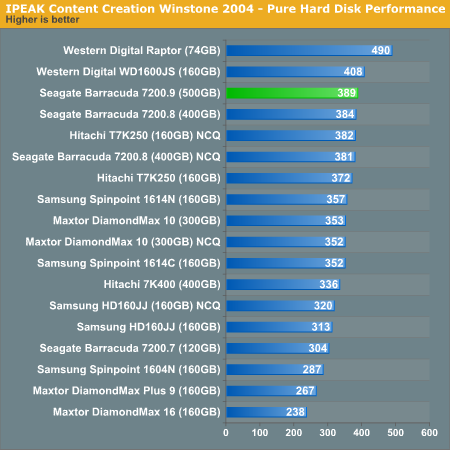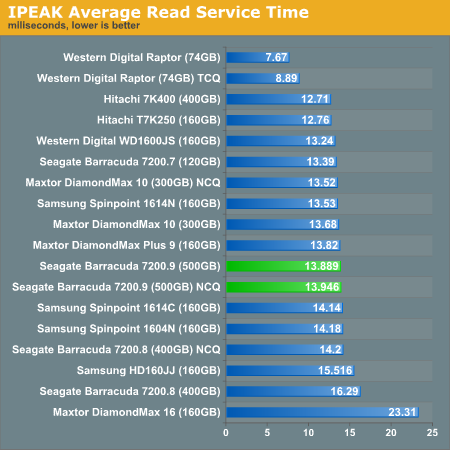Seagate 7200.9 500GB: Mouthwatering Benchmarks
by Purav Sanghani on October 24, 2005 12:05 AM EST- Posted in
- Storage
Pure Hard Disk Performance - IPEAK
We begin our usual hard disk drive test session with Intel's IPEAK benchmarking utility. We first run a trace capture on Winstone 2004's Business and Multimedia Content Creation benchmark runs to catch all of the IO operations that take place during each test. We then play back each capture using RankDisk, which reports back to us a mean service time, or average time that the drive takes to complete an IO operation.
Let's take a look at Content Creation performance.
We begin our usual hard disk drive test session with Intel's IPEAK benchmarking utility. We first run a trace capture on Winstone 2004's Business and Multimedia Content Creation benchmark runs to catch all of the IO operations that take place during each test. We then play back each capture using RankDisk, which reports back to us a mean service time, or average time that the drive takes to complete an IO operation.

Let's take a look at Content Creation performance.












46 Comments
View All Comments
Spacecomber - Monday, October 24, 2005 - link
The results from these benchmarks were about as mouthwatering as a rice cake with nothing on it.jeffrey - Monday, October 24, 2005 - link
Titling the article "Mouthwatering Benchmarks" and then reading the mid-pack performance lowers the author's credibility.The drive is big, but it uses lower density plattters, has the highest idle heat, has the highest heat under load, and is 2.6 decibels louder than a 10Krpm Raptor when transferring. Overall performance was mid-pack and not mouth watering.
****************************************************
It would have been a solid review without the title.
Much better than recent video card reviews.
****************************************************
ss284 - Monday, October 24, 2005 - link
Pretty dissapointing figures considering all the marketing crap that was posted a couple weeks back as a full fledged preview on anandtech. The drive neither runs cooler or quieter or faster than the previous generation of drives. Other than the 5 year warranty this drive has nothing over a model from a competing manufacturer, most notably hitachi. Im also suprised that the 160 gb model wasnt tested, since it has 160 gb platters, instead of the 125 in the 500gb model.LoneWolf15 - Monday, October 24, 2005 - link
One other thing that it has over Hitachi: Seagate (along with WD and Maxtor) offer advance replacement in the event of failure. Hitachi, unfortunately, does not.It may sound like a minor gripe, but if I'm trying to save a client's data off a failing drive, it's nice to have the replacement drive handy. Since I've also had a drive company lose a drive on me in the RMA process (not a common occurrence, but I've had it happen) I feel far more secure having advance replacement. I do agree though that performance specs are not as good as expected; the difference is small enough that I'd save money and buy the previous Seagate 7200.8 drives.
smn198 - Monday, October 24, 2005 - link
Please benchamrk the 160GB modelPenth - Monday, October 24, 2005 - link
"you're better off working with a 15K RPM Raptor for now."I think you meant 10K RPM Raptor, unless WD just dropped a bomb.
First Post.